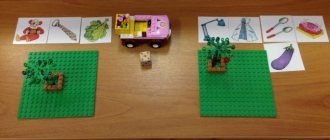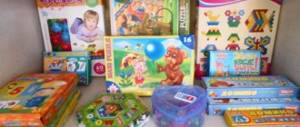Didactic games in art classes in kindergarten
Didactic games for preschoolers
Didactic games in art classes in kindergarten"
Author: Matveeva Evgenia Aleksandrovna, teacher at MDOU - kindergarten No. 16 "Malyshok", Serpukhov, M.O.
Sometimes it can be very difficult to explain some material to a child. And of course it’s even more difficult to explain it so that he remembers it. And here didactic games come to the aid of the teacher. They are used in the educational process from the very beginning of a child’s learning to draw. I bring to your attention examples of such games that I use in my work. 1. Game “Colored baskets”
The first game is used with very young children and is called “Colored Baskets”.
Purpose of the game: the game is aimed at learning colors by children 2.5-3.5 years old, memorizing the names of primary colors, developing the speech skills of preschoolers, developing observation and memory. Progress of the game: children are asked to collect mixed up objects in baskets, the child draws any card, but he must put it in a basket of the same color, while loudly calling out the color and the object he chose.
2. Game “Bottom of the Sea”
Purpose of the game: development of artistic composition skills, development of speech, logical thinking, memory. A very common game that can be used not only in art activities, but also in other educational areas. The children are shown the seabed (empty), and it must be said that all the sea inhabitants wanted to play “Hide and Seek” with us, and in order to find them we need to guess riddles about them. The one who guessed correctly puts the resident in the background. The result is a complete composition. The teacher motivates children to perform visual activities. (Good to use with middle and older groups). In the same way, you can study with children other themes of plot compositions: “Summer Meadow”, “Forest Dwellers”, “Autumn Harvest”, “Still Life with Tea”, etc. You can invite several children to the board and ask them to make different compositions from the same objects. This game develops intelligence, reaction, and compositional vision.
3. Game “Painted Horses”
When consolidating knowledge of folk paintings or when conducting monitoring in senior and preparatory groups, you can use this simple game.
Goal: to consolidate knowledge of the main motifs of Russian folk paintings (“Gzhel”, “Gorodets”, “Filimonovo”, “Dymka”), to consolidate the ability to distinguish them from others, to name them correctly, to develop a sense of color. Progress of the game: the child needs to determine in which clearing each of the horses will graze, and name the type of applied art based on which they are painted.
4. Game “Magic Landscape”
One of the most difficult topics is, of course, the study of perspective in a landscape - distant objects seem smaller, near ones larger.
It is also more convenient to use the game for this. Purpose of the game: to teach children to see and convey the properties of spatial perspective in drawings, to develop the eye, memory, and compositional skills. Progress of the game: The child needs to place trees and houses in pockets according to their size according to their perspective distance. (preparatory group).
5
. Game "Collect a landscape"
Using the example of a landscape, it is also convenient to develop a sense of composition and knowledge of natural phenomena.
To do this, it is convenient to use this didactic game. Purpose of the game: to develop compositional thinking skills, consolidate knowledge of seasonal changes in nature, consolidate knowledge of the concept of “landscape,” develop observation and memory. Progress of the game: the child is asked to create a landscape of a certain season (winter, spring, autumn or winter) from a set of printed pictures; the child must select objects corresponding to this particular time of year and, using his knowledge, build the correct composition.
6.Game “Arrange and count the nesting dolls”
Purpose of the game: to consolidate knowledge about the Russian nesting doll, develop the ability to distinguish this type of creativity from others, develop ordinal counting skills, eye, and reaction speed.
Progress of the game: Leaves with drawn silhouettes of nesting dolls hang on the board, three children are called and they must quickly arrange the nesting dolls into cells and count them.
7. Game “Matryoshkin’s sundress”
Purpose of the game: to develop compositional skills, consolidate children’s knowledge about the basic elements of painting a Russian nesting doll, and consolidate knowledge of Russian national clothing. Progress of the game: Silhouettes of three nesting dolls are drawn on the board, the teacher calls three children in turn, they each choose to wear their own nesting doll.
Each of these games can be drawn by yourself or made using a computer and a color printer.
We recommend watching:
Didactic games with sand for children 3-4-5 years old. Didactic games (verbal) for children 5-6 years old. Didactic game for children 6-9 years old. Fun vegetable garden Didactic game for younger preschoolers
Similar articles:
Didactic game “Collect a caterpillar” for children 5-6-7 years old
Didactic game “Find a Pair” for children 3-4 years old
Didactic game "Flowers" for children 5-6-7 years old
Didactic game for the development of fine motor skills of children 3 – 7 years old
Didactic game for preschoolers. Formation of ideas about time
Card index of games for artistic and aesthetic development
Progress of the game:
Objects are partially drawn in the pictures (bunny, Christmas tree.). You need to recognize the subject, fill in the parts that are missing, and color it.
“Let’s prepare the table for the holiday”
Target:
develop the ability to select shades of primary colors and create a beautiful color scheme.
Progress of the game:
In front of the children are cut out paper tablecloths of different colors (red, yellow, blue, green) and 4 - 5 shades of paper tableware of each color. The task is to match the main color to its shades. Select tableware so that the color matches the tablecloth.
Board game "Domino"
Target:
To consolidate children's knowledge about arts and crafts - toys; the ability to find the right toy and justify your choice. To consolidate knowledge about the manufacture of folk toys and the features of each. Cultivate a love of beauty.
“Paint a scarf for mom”
Target:
To consolidate children's knowledge about the art of the Russian shawl. To develop children's aesthetic taste, to teach them how to make simple patterns from various decorative elements (flowers, leaves, buds, twigs, etc.), and the ability to select the color scheme of a pattern.
"Art Crafts"
Target
: To consolidate children’s knowledge about folk arts and crafts; find the desired trade among others and justify your choice.
"Collect a Gzhel rose"
Target
: To consolidate children’s ability to compose a Gzhel rose using appliqué based on Gzhel painting, to maintain interest in Gzhel craft.
"Collect a matryoshka doll"
Target:
To consolidate children's knowledge about the folk toy - matryoshka; the ability to assemble a nesting doll from parts using the mosaic method. Highlight decoration elements. To cultivate respect and love for folk art.
“Complete the pattern”
Target:
The game is aimed at developing children's attention and memory, developing a sense of symmetry followed by coloring.
Progress of the game:
The beginning of the pattern is drawn on a piece of paper. Children need to extend the pattern further and color it.
“Find friends among the colors”
Target:
discover the level of children’s knowledge in choosing paint that matches the color of the object; draw in color
Progress of the game:
Silhouettes of objects are drawn on sheets of paper. The teacher gives the task to find “friends” of yellow, green, blue, and red colors among the objects. Children find objects that match a certain color and color them.
“Make a still life”
Target:
improve compositional skills, the ability to create a composition on a specific topic (still life), highlight the main thing, establish a connection by arranging the image in space.
Progress of the game:
The envelope contains images of various vegetables, fruits, as well as various vases, plates, dishes, and baskets. Children need to choose objects and create their own still life.
Game index
Didactic games for artistic and aesthetic development will help create additional motivation for preschool children and present them with new material in an accessible, fun way. With the help of didactic material, children get the opportunity to come into more detailed and imaginative contact with the world of art in everyday, real life. The following activities contribute to this:
Class
- Various types of visual arts (painting, modeling, applique, paper-making, applied arts).
- Musical development (singing, listening to works, playing musical instruments, rhythm, plasticity, pantomime).
- Theatrical and artistic activities (listening and retelling fairy tales and other literary works, role-playing games, theatrical performances and their discussion).
Important! It is necessary to observe the age-related characteristics of the child’s development when choosing topics and designing activities. This will help kids not only learn new terms and concepts, but also master useful skills and abilities.
In the younger group
At the age of 2-3 years, the active formation of the speech apparatus occurs. Classes during this period should combine the consolidation of concepts with the opportunity to develop the baby’s fine motor skills.
Drawing
Beautiful pyramids, cubes, bright flags, busy boards, and finger paints are especially suitable for this purpose. When playing, you must pronounce the name, color and shape of the object.
Telling stories and fairy tales will bring the greatest results for listeners if it is accompanied by action. For example, a table theater made of cardboard or felt. The use of Russian folk instruments also increases the emotional level of perception.
In the middle group
At this age, children willingly learn everything new. The main goals of teachers:
- Develop primary drawing skills and techniques using various materials: pencils, paints, crayons and felt-tip pens.
- Get children interested in making crafts from various materials: paper, felt, plasticine, wool, natural raw materials.
- Thematic activities can be illustrated and supplemented with reproductions of paintings and fragments of classical music, while at the same time focusing on folklore and folk music.
- Continue to get acquainted with the theater, play out fairy tales in round dance games and skits. An addition will be thematic classes telling about creative professions.
Experimental activities in the senior group
The teacher performs all stages of the lesson together with the children, talking through all his actions in detail.
In the older group
Didactic games for artistic and aesthetic development in the senior group have their own characteristics:
- Children aged 5-6 years are able to independently obtain information using board games. With their help, terms and concepts characteristic of creative activities (musical instruments, artist's materials, crafts, literary works and fairy-tale characters) are well established. Musical works are divided into genres. Choral singing and playing musical instruments are developing.
- New tasks appear in drawing - depicting genre pictures, scenes on a given topic. Children also get acquainted with different types of folk painting.
- Theatricalization is manifested in performances dedicated to matinees, thematic classes and national holidays.
Educational game
Need to know! The teacher explains in detail the task assigned to the children, without taking part in its implementation, but carefully observing the actions of the students.
In the preparatory group
From the first week of September, classes are aimed at preparing for school. Future first-graders must have a developed imagination, an understanding of social and social norms, and be able to work not only individually, but also in a team. During this period, classes and assignments for children are designed in such a way as to help open the creative possibilities hidden in children and activate their observation and curiosity.






